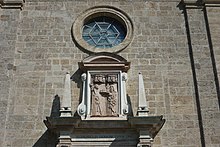St. Quirin (Tegernsee)

The former St. Quirin monastery church is the focus of the building complex of the former Tegernsee monastery . Since its abolition in 1803, it has been used as a Catholic parish church for the town of Tegernsee with its characteristic western double tower facade .
history
According to legend, the monastic community at Tegernsee came into being around the middle of the 8th century (746 or 765) when the brothers Oatkar and Adalbert , who belonged to the old Bavarian aristocratic Huosi family , were founded. The relics of St. Quirinus are said to have been transferred as a gift from Pope Zacharias to the Salvator Church in Tegernsee , which they founded .
After the fall of the Bavarian Duke Tassilo III. (748–788) Tegernsee became a Carolingian royal monastery. Hungarian invasions and secularizations at the time of the Bavarian Duke Arnulf (907–937) threatened the spiritual community . In the course of the 10th century, monastic life in the Tegernsee monastery is said to have almost died out. The re-establishment of Tegernsee as a Benedictine imperial abbey in 978, co-initiated by Emperor Otto II (973–983) , led to a renewal of monasticism and monastery. Parts of the crypt and the lower parts of the western double tower facade may still date from this period.
This church from the end of the 10th century was converted into a three-aisled Romanesque basilica in the 11th century . After a fire in the monastery in 1410, large parts of both the monastery and the church were rebuilt in the late Gothic style . Around 1476 the large three-aisled basilica without a transept was completed, which still forms the structural core of the church today. The wooden roof structure of her has largely been preserved. The two west towers still show the brick masonry from this time on the inside of the bell storey and also still have the roof trusses of the tower spiers, but their outer shape was later changed.
From 1678 carried out according to the plans of Enrico Zuccalli a Baroque style of the church, in a crossing and a transept were added. The rich stucco work and the complex pictorial program in the vault were created by the painter and sculptor Hans Georg Asam until around 1694 . The high grave created in 1457 by the Munich sculptor Hans Haldner for the monastery donors Adalbert and Otkar was demolished during the Baroque era, but the cover plate was attached in a new frame (dated 1690) as a crowning over the entrance portal. On the occasion of the 1000th anniversary of the monastery in 1746, Rococo chapels in honor of Saints Quirinus and Benedict with sculptures by Johann Baptist Straub were built on both side aisles .
After the abolition of the monastery during the secularization in Bavaria in 1803, significant parts of the monastery complex were demolished and other parts were converted into a Wittelsbach castle . The monastery church was subsequently used as a parish church for the town of Tegernsee .
Around 1820 the eastern choir was separated from the church and the facade was redesigned in a classical style by Leo von Klenze . A renovation took place immediately after the Second World War (for the 1200th anniversary of Tegernsee in 1946). The refurbishment of the chancel, created in 2004, comes from the Swiss artist Kurt Sigrist .
organ
The organ was built in 1980 by Georg Jann . It has 33 registers on three manuals and a pedal . The disposition is:
|
|
|
|
||||||||||||||||||||||||||||||||||||||||||||||||||||||||||||||||||||||||||||||||
- Link : III / P, II / P, I / P, III / II, III / I, II / I
- Playing aids : 5-fold mechanical combination
- Comments: sliding drawer , mechanical play and stop action
Monument protection
The church of St. Quirin, like the convent of the former Benedictine monastery, is a listed building . The church is described in the list of monuments of the Bavarian State Office for Monument Preservation as follows:
"Former St. Quirin monastery church, now a Catholic parish church, three-aisled pillar basilica with transept, side chapels, central nave-wide choir and western double-tower facade, towers and crypt in the 11th century core, psallier choir and three-aisled nave 15th century, from 1678 Baroque style and insertion of transept and transept Plan by Enrico Zuccalli, around 1820 separation of the eastern Psallier choir and redesign of the facade by Leo von Klenze "
Web links
literature
- Sixtus Lampl : The Tegernsee monastery church. In: Upper Bavarian Archive. 100: 5-141 (1975) and Tafelband.
- Josef Hemmerle : The Benedictine monasteries in Bavaria (= Germania Benedictina. Volume 2). Ottobeuren 1970, p. 297 ff.
- Klaus Kratzsch: District Miesbach (= Bavarian State Office for Monument Preservation [Hrsg.]: Monuments in Bavaria . Volume I.15 ). 2nd improved edition. Munich / Zurich 1987.
Individual evidence
- ↑ geodaten.bayern.de: Bavarian State Office for Monument Protection - Technical Information ( Memento from April 15, 2014 in the Internet Archive ) , accessed on November 3, 2011
- ↑ cf. Franz Brunhölzl: Handbook of Bavarian History: Vol. 1 - The old Bavaria, the tribal duchy until the end of the 12th century. CH Beck, 1981, ISBN 3-40607322-0 , pp. 213-214.
- ^ Walter Troxler: St. Quirin (Tegernsee). In: Biographisch-Bibliographisches Kirchenlexikon (BBKL). Volume 7, Bautz, Herzberg 1994, ISBN 3-88309-048-4 , Sp. 1132-1133.
- ^ Eva Wagner-Langenstein: Georg Asam (1649–1711). Oil painter and fresco artist in baroque old Bavaria. Schnell and Steiner Artist Library, Munich / Zurich 1986, ISBN 3-7954-0371-5 .
- ↑ Dorothea Minkels: Elisabeth von Preussen. Queen in the time of MARCHING out. 2008, p. 65.
- ↑ Bavarian organ database online
- ↑ List of monuments for Tegernsee (PDF) at the Bavarian State Office for Monument Preservation
Coordinates: 47 ° 42 ′ 26.6 " N , 11 ° 45 ′ 24" E




